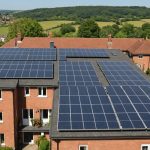Understanding the Importance of Double Glazing in Historic Buildings
Incorporating double glazing into historic buildings is a balancing act between historic preservation and modernisation. The primary benefit of double glazing is its contribution to energy efficiency. By reducing heat loss, it cuts down on energy consumption, offering both economic and environmental benefits.
Historically, listed buildings have sought to maintain their authentic aesthetic while upgrading essential services. The challenge lies in integrating modern double glazing without compromising heritage value. Many historic windows are single-glazed, leading to significant heat loss; double glazing offers a discreet solution to mitigate this issue.
Avez-vous vu cela : Maximizing Solar Efficiency: The Best Panel Arrangement for Terraced Roofs in Reading
Installing double glazing in a way that respects the original architecture requires careful consideration. Solutions such as secondary glazing, which involves adding an additional pane to the existing window frame, can provide energy savings without altering the building’s appearance.
The adoption of double glazing can significantly reduce carbon footprints and enhance comfort without detracting from the building’s charm. Striking this balance ensures that historic buildings can maintain their legacy while meeting contemporary energy efficiency standards. Thus, the integration of double glazing is not only a technological improvement but also an essential step in sustainable historic conservation.
A lire également : Top Energy-Saving Cooking Techniques for Your UK Kitchen: Maximize Efficiency and Minimize Bills
Key Considerations for Retrofitting Double Glazing
When retrofitting double glazing, understanding local regulations is crucial for ensuring compliance. Local regulations often dictate specific standards and requirements for renovations, especially when properties are located in heritage areas. Adhering to heritage regulations is vital, as they are set to preserve the architectural integrity of historic buildings.
Choosing the right retrofitting techniques is essential to meet these compliance standards. Techniques such as secondary glazing, where an additional pane is added without altering the existing window, often satisfy both modern efficiency standards and heritage guidelines. Proper selection of materials is necessary to maintain the building’s original aesthetic while enhancing its energy efficiency.
However, one of the main challenges in retrofitting projects is striking a balance between modernisation and heritage compliance. Implementing retrofitting techniques that blend seamlessly with the original design can be complex, requiring skilled labour and detailed planning. It’s imperative to select materials that not only offer thermal efficiency but also align with heritage aesthetics.
A proactive approach involves consulting with heritage specialists and understanding material compatibility, ensuring any changes are both effective and allowed under heritage regulations. Successfully navigating these considerations can lead to improved comfort and energy savings without compromising historical value.
Best Practices for Retrofitting Double Glazing
Retrofitting double glazing, particularly in historic buildings, requires specialised installation methods. The choice of technique can greatly impact the structural integrity and aesthetics of these cherished edifices. For instance, many experts recommend using slimline double-glazing units. These units preserve the original features of heritage properties while offering modern insulation benefits.
One effective method includes secondary glazing, which involves installing an additional layer of glazing on the interior side of existing windows. This method not only enhances thermal efficiency but also maintains historic integrity. Moreover, expert opinions suggest that modifying window seals can drastically reduce heat loss without disturbing the building’s architecture.
Common pitfalls in retrofitting often include poor-quality installations, which lead to condensation issues. To avoid such problems, prioritising experienced professionals and high-grade materials is crucial. Checking for sufficient ventilation around windows also prevents moisture build-up.
Implementing these best practices ensures that retrofitting double glazing enhances energy efficiency while respecting the unique characteristics of historic buildings. With informed decisions and attention to detail, it’s possible to balance preservation with modern comfort effectively.
Case Studies of Successful Double Glazing Retrofit Projects
When considering double glazing retrofit projects, case studies serve as valuable resources for understanding potential outcomes. In York, a city renowned for its historical architecture, several projects have successfully integrated modern glazing while honouring heritage conservation principles. For instance, a notable project involved retrofitting a Victorian townhouse. The team faced challenges balancing energy efficiency with conservation efforts. By using bespoke windows that matched the original design, they achieved optimal thermal performance without compromising the building’s historical aesthetics.
In another example, a retrofit in a Georgian-style property reduced heating bills by 30%. Key lessons learned here include the importance of selecting materials and methods that respect the architectural integrity of heritage buildings. These projects’ outcomes highlight the feasibility of double glazing in preserving historical heredity while enhancing energy efficiency.
Energy savings often arise as the principal objective and common success measure. Retrofitting with carefully chosen glazing solutions can result in significant energy savings, sometimes reducing energy consumption by up to 40%. Such projects not only protect the architectural charm but also enhance the building’s functionality and longevity. These insights ensure future retrofitting initiatives are grounded in proven successful strategies.
Cost Estimates and Financial Considerations
Understanding the financial implications of retrofitting double glazing is crucial when planning such projects. The initial cost estimates can vary significantly based on factors like property size and window specifications. However, it’s essential to weigh these expenses against potential energy savings and increased property value over time.
When considering funding options, numerous incentives and grants exist, particularly for heritage projects. These can substantially offset initial costs. Investigating local government programs or environmental grants can provide financial relief and make retrofitting more accessible.
In assessing the balance between long-term benefits and initial investment, financial considerations become a guiding factor. Retrofitting with double glazing can significantly reduce energy bills, improve thermal comfort, and lower carbon footprint. While upfront costs might seem daunting, the reduction in energy consumption can lead to substantial savings over time.
By exploring available funding options and potential incentives, alongside careful cost analysis, property owners can make informed decisions. This approach not only ensures financial viability but also aligns with sustainable living practices.
Environmental Impact of Double Glazing Retrofitting
Double glazing retrofitting offers a significant opportunity to enhance sustainability through notable energy savings. This approach helps reduce the carbon footprint of buildings by improving their energy efficiency. Retrofitting with double glazing essentially decreases the reliance on heating and cooling systems, contributing to lower energy consumption.
In historic buildings, sustainability is a challenge due to traditional structures often characterised by poor thermal performance. By retrofitting these buildings with double glazing, not only is energy efficiency improved, but it also helps maintain the architectural integrity of the building, aligning with preservation efforts. This dual benefit promotes a more sustainable future while respecting the past.
Double glazing retrofitting aligns with many local environmental goals, such as reducing emissions and conserving resources. By lowering energy use, these initiatives directly contribute to achieving sustainability targets. The potential contribution to such goals cannot be understated, as they reinforce a region’s commitment to combating climate change and fostering greener living environments. Thus, double glazing retrofitting emerges as a pivotal step in advancing environmental objectives while ensuring the efficient use of resources.











